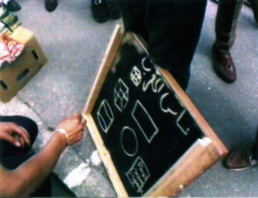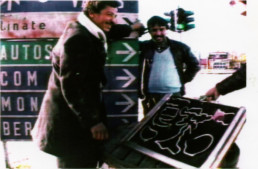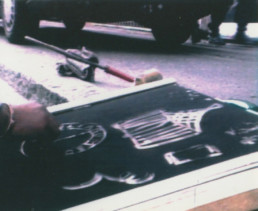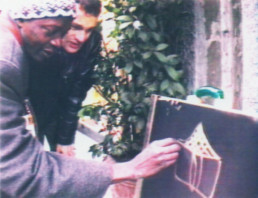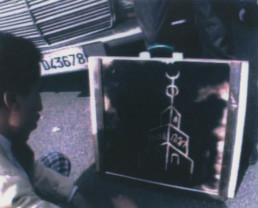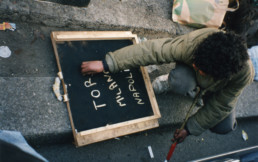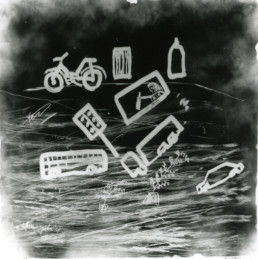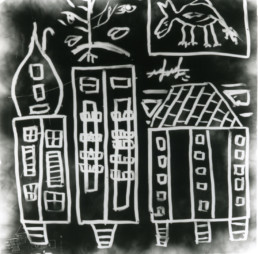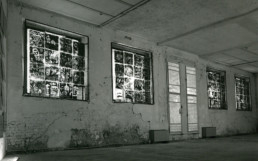Vetri da lavare 1990/93
For the exhibition “Incroci di voci”, Viafarini Space, Milan; edited by Emanuela De Cecco. Samia Kouder, sociologist, Francesca Corrao, professor of Islamic culture, Azamouz Abdelhak, Hocine El-Kabic and other intercultural mediators attended the inauguration meeting.
As far as I’m concerned, window washers have never a problem; if anything, the problem is the suvs, which, being tall cars, have windscreens that are difficult to reach and clean. At the beginning of the 1990s, with the first arrivals of Maghreb immigrants in Milan, attracted by their culture and by the curious cleaning job, I tried with great patience to approach and create an empathic relationship through drawing. Over a long period I delved into their everyday spaces, creating a network of urban and peripheral connections with the foreigner, exploring places that I had never had the opportunity to know before. I showed up at the crossroads of traffic lights on the streets where they worked, and with a glass plate blackened by me with the smoke from a kerosene lamp – then used as a road obstacle warning – trying to make myself understood and to overcome their legitimate distrust, I asked them to do a drawing as they pleased on the glass, sometimes in exchange for a few coins. This “moving towards”, an urban crossing process that led me into spaces and situations of survival and clandestine life, gave me the opportunity to absorb their everyday life to the point of feeling myself clandestine and that there was no need to add other external elements, if not to put into practice, from another point of view, an action with their own working methods and tools. Over time, many traces and drawings of various kinds have remained imprinted on the numerous glass plates: the Moroccan vegetable garden, the spices, the birthplace, the animals, the mosque, but also the advertisements, the city, the landscape … as if it were an archive of drawings that tells the immigrant’s desires. The glass panels are the final part of a long process of involvement, a street work and a journey made up of encounters that have led me to meet many people and places of an “other” culture. The waste remnant of an “analogic soul” belonging to the migratory process of those years. In the transition to digital, since then, to what extent and how has the phenomenon of migration and integration really evolved in Italy? “Glass to wash, is a concentration of worlds and cultures that is worth more than the many debates that take stock of the cultural integration of non EU immigrants in our cities.” Emanuela De Cecco (Overture Flash Art 1993)
_
Per quanto mi riguarda i lavavetri non sono mai stati un problema; casomai il problema sono i suv, che, essendo vetture alte, hanno il vetro difficile da pulire. Agli inizi degli anni ‘90, con i primi arrivi di immigrati magrebini a Milano, attratto dalla loro cultura e dal curioso lavoro di pulizia, con molta pazienza ho cercato di avvicinarmi e di creare una relazione empatica mediante il disegno. In questo lungo periodo mi sono addentrato nei loro spazi di quotidianità creando come una rete di connessioni urbane e periferiche con lo straniero, esplorando luoghi che non avevo mai avuto modo di conoscere prima. Mi presentavo agli incroci dei semafori delle strade dove lavoravano, e con una lastra di vetro da me annerita con una boccia al cherosene – allora utilizzata come segnale di ostacolo stradale- cercando di farmi capire e di superare la loro legittima diffidenza, chiedevo di fare un disegno a piacimento sul vetro, a volte in cambio di qualche monetina. Questo “muovermi verso”, pratica di attraversamento urbano che mi conduceva in spazi e situazioni di sopravvivenza e vita clandestina, mi ha dato modo di assorbire la loro quotidianità al punto di sentirmi io stesso clandestino e che non c’era bisogno di aggiungere altri elementi esterni, se non mettere in pratica, da un altro punto di vista, un’azione con le loro stesse modalità e strumenti di lavoro. Nell’arco del tempo sono rimaste impresse sulle numerose lastre molte tracce e disegni di vario genere: l’orto marocchino, le spezie, la casa natale, gli animali, la moschea, ma anche le pubblicità, la città, il paesaggio… come se fosse un archivio di disegni che racconta i desideri dell’immigrato. I vetri sono parte conclusiva di un lungo processo di coinvolgimento, di un lavoro da marciapiede e di un percorso fatto di incontri che mi hanno portato a conoscere tante persone e luoghi di una cultura “altra”. Lo scarto di un rimasuglio di “anima analogica” appartenente al processo migratorio di quegli anni. Nel passaggio al digitale, da allora, quanto e come si è realmente evoluto il fenomeno migrazione e integrazione in Italia? “Vetri da lavare è un concentrato di mondi e di culture che vale più di tanti dibattiti che fanno il punto sull’integrazione culturale degli immigrati extracomunitari nelle nostre città.” Emanuela De Cecco (Ouverture Flash Art 1993)
